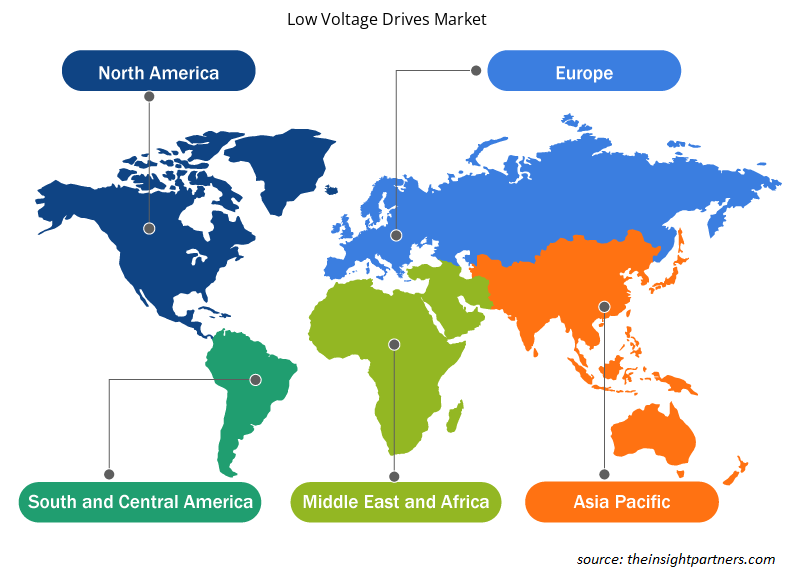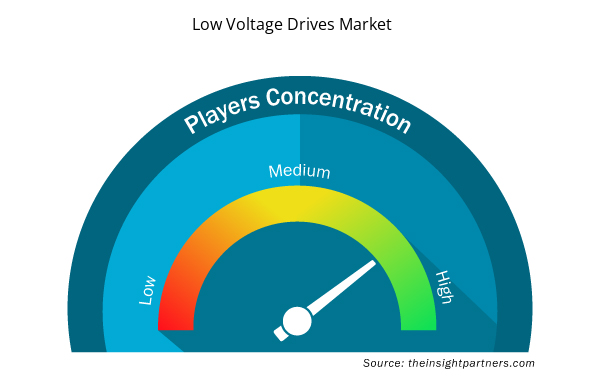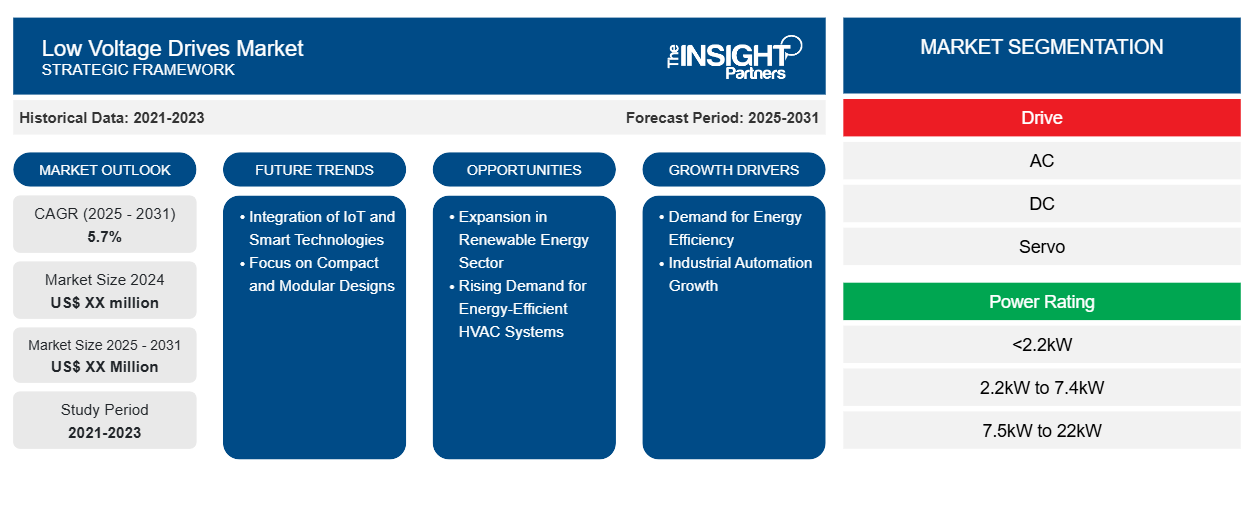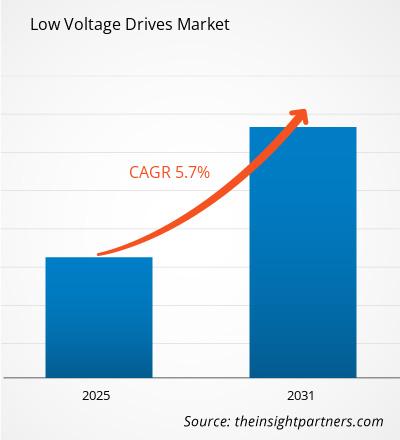من المتوقع أن يسجل سوق محركات الجهد المنخفض معدل نمو سنوي مركب بنسبة 5.7٪ من عام 2024 إلى عام 2031، مع توسع حجم السوق من XX مليون دولار أمريكي في عام 2024 إلى XX مليون دولار أمريكي بحلول عام 2031.
تم تقسيم التقرير حسب المحرك (تيار متردد، تيار مستمر، سيرفو)، تصنيف الطاقة (500 كيلو وات)، التطبيق (المضخة، المروحة، الناقل، الضاغط، الطارد، وغيرها)، المستخدم النهائي (النفط والغاز، توليد الطاقة، التعدين واللب، السيارات، معالجة الأغذية، وغيرها). تم تقسيم التحليل العالمي بشكل أكبر على المستوى الإقليمي والدول الرئيسية. يقدم التقرير القيمة بالدولار الأمريكي للتحليل والقطاعات المذكورة أعلاه.
غرض التقرير
يهدف تقرير سوق محركات الجهد المنخفض الصادر عن The Insight Partners إلى وصف المشهد الحالي والنمو المستقبلي وأهم العوامل الدافعة والتحديات والفرص. وسيوفر هذا رؤى لمختلف أصحاب المصلحة في الأعمال التجارية، مثل:
- مزودي/مصنعي التكنولوجيا: لفهم ديناميكيات السوق المتطورة ومعرفة فرص النمو المحتملة، وتمكينهم من اتخاذ قرارات استراتيجية مستنيرة.
- المستثمرون: إجراء تحليل شامل للاتجاهات فيما يتعلق بمعدل نمو السوق، وتوقعات السوق المالية، والفرص المتاحة عبر سلسلة القيمة.
- الهيئات التنظيمية: لتنظيم السياسات ومراقبة الأنشطة في السوق بهدف تقليل الانتهاكات والحفاظ على ثقة المستثمرين والحفاظ على سلامة السوق واستقرارها.
تجزئة سوق محركات الجهد المنخفض
يقود
- التيار المتردد
- دي سي
- سيرفو
تصنيف الطاقة
- 500 كيلو واط
طلب
- مضخة
- معجب
- ناقل
- ضاغط
- الطارد
- آحرون
المستخدم النهائي
- النفط والغاز
- توليد الطاقة
- التعدين واللب
- السيارات
- معالجة الأغذية
- آحرون
قم بتخصيص هذا التقرير ليناسب متطلباتك
ستحصل على تخصيص لأي تقرير - مجانًا - بما في ذلك أجزاء من هذا التقرير، أو تحليل على مستوى الدولة، وحزمة بيانات Excel، بالإضافة إلى الاستفادة من العروض والخصومات الرائعة للشركات الناشئة والجامعات
- احصل على أهم اتجاهات السوق الرئيسية لهذا التقرير.ستتضمن هذه العينة المجانية تحليلاً للبيانات، بدءًا من اتجاهات السوق وحتى التقديرات والتوقعات.
الجهد المنخفض يحفز نمو السوق
- الطلب على كفاءة الطاقة: تعد كفاءة الطاقة مصدر قلق متزايد في مختلف الصناعات، مما يدفع الشركات إلى الاستثمار في التقنيات التي تقلل من استهلاك الطاقة. تعد محركات الجهد المنخفض (LVDs) مفتاحًا لتحقيق هذه الأهداف من خلال تحسين تشغيل المحركات الكهربائية في تطبيقات مختلفة. من خلال ضبط سرعة المحرك وعزم الدوران، تساعد محركات الجهد المنخفض في تقليل هدر الطاقة وتحسين الكفاءة التشغيلية وخفض تكاليف الطاقة. هذا الطلب على حلول توفير الطاقة يدفع سوق محركات الجهد المنخفض، وخاصة في قطاعات مثل التصنيع وتكييف الهواء والتدفئة ومعالجة المياه.
- نمو الأتمتة الصناعية: يعد توسع الأتمتة الصناعية محركًا مهمًا لسوق محركات الجهد المنخفض. مع تبني الصناعات للأنظمة الآلية لتحسين الإنتاجية، تلعب محركات الجهد المنخفض دورًا حاسمًا في التحكم في سرعة المحركات وتشغيلها، مما يضمن الأداء الأمثل. تتطلب الأنظمة الآلية، مثل أحزمة النقل والمضخات والمراوح، التحكم الدقيق في المحرك، وهو ما توفره محركات الجهد المنخفض. إن الطلب المتزايد على الأتمتة عبر الصناعات مثل التصنيع والسيارات وصناعات العمليات يدفع الحاجة إلى محركات الجهد المنخفض الأكثر كفاءة وموثوقية.
الجهد المنخفض يحرك اتجاهات السوق المستقبلية
- دمج إنترنت الأشياء والتقنيات الذكية: يعد دمج إنترنت الأشياء والتقنيات الذكية في محركات الجهد المنخفض اتجاهًا ملحوظًا في السوق. تسمح محركات الجهد المنخفض التي تدعم إنترنت الأشياء بالمراقبة عن بُعد والصيانة التنبؤية وتحليل الأداء في الوقت الفعلي، مما يساعد الشركات على تقليل وقت التوقف وتحسين الكفاءة. هذا الاتجاه نحو المحركات الذكية بارز بشكل خاص في الصناعات مثل التدفئة والتهوية وتكييف الهواء ومعالجة المياه والتصنيع، حيث تعد العمليات المستمرة وتحليل البيانات في الوقت الفعلي أمرًا بالغ الأهمية. مع سعي الصناعات بشكل متزايد إلى الأتمتة وقدرات التحكم عن بعد، تكتسب محركات الجهد المنخفض الذكية شعبية.
- التركيز على التصميمات المدمجة والمعيارية: يركز مصنعو محركات الجهد المنخفض على التصميمات المدمجة والمعيارية لتلبية الطلب المتزايد على حلول توفير المساحة. يسهل دمج هذه المحركات المدمجة في الأنظمة الحالية وتوفر مرونة أفضل في التطبيقات المختلفة. بالإضافة إلى ذلك، تسمح التصميمات المعيارية بالتخصيص وقابلية التوسع، وتلبي الاحتياجات المحددة للصناعات ذات المتطلبات التشغيلية المتنوعة. يساعد هذا الاتجاه الشركات على تقليل تكاليف التثبيت وتحسين استخدام المساحة مع الحفاظ على مستويات عالية من الأداء وكفاءة الطاقة.
فرص سوق محركات الجهد المنخفض
- التوسع في قطاع الطاقة المتجددة: إن الاستخدام المتزايد لمصادر الطاقة المتجددة مثل الطاقة الشمسية وطاقة الرياح يقدم فرصًا كبيرة لسوق محركات الجهد المنخفض. غالبًا ما تتطلب هذه الأنظمة التحكم الدقيق في المحركات وتطبيقات السرعة المتغيرة للمضخات والمراوح والضواغط. تعد محركات الجهد المنخفض ضرورية في أنظمة الطاقة المتجددة لتحسين الكفاءة وضمان التشغيل السلس. مع استمرار نمو سوق الطاقة المتجددة، سيزداد الطلب على محركات الجهد المنخفض في أنظمة إنتاج الطاقة وتخزينها وتوزيعها، مما يخلق فرصًا جديدة للمصنعين.
- الطلب المتزايد على أنظمة التدفئة والتهوية وتكييف الهواء الموفرة للطاقة: تعد كفاءة الطاقة في أنظمة التدفئة والتهوية وتكييف الهواء (HVAC) محركًا رئيسيًا في سوق محركات الجهد المنخفض. مع سعي الشركات والمستهلكين السكنيين إلى خفض تكاليف الطاقة، تقدم LVDs حلاً فعالاً من خلال التحكم في سرعات المحرك في أنظمة التدفئة والتهوية وتكييف الهواء. يتزايد الطلب على الأنظمة الموفرة للطاقة، وخاصة في المناطق ذات المناخات القاسية. وهذا يوفر فرصة نمو كبيرة لمصنعي LVD لتلبية الطلب المتزايد على حلول التدفئة والتهوية وتكييف الهواء الموفرة للطاقة، مما يدفع السوق إلى الأمام.
رؤى إقليمية حول سوق محركات الجهد المنخفض
لقد قام المحللون في Insight Partners بشرح الاتجاهات والعوامل الإقليمية المؤثرة على سوق محركات الجهد المنخفض طوال فترة التوقعات بشكل شامل. يناقش هذا القسم أيضًا قطاعات سوق محركات الجهد المنخفض والجغرافيا في جميع أنحاء أمريكا الشمالية وأوروبا ومنطقة آسيا والمحيط الهادئ والشرق الأوسط وأفريقيا وأمريكا الجنوبية والوسطى.

- احصل على البيانات الإقليمية المحددة لسوق محركات الجهد المنخفض
نطاق تقرير سوق محركات الجهد المنخفض
| سمة التقرير | تفاصيل |
|---|---|
| حجم السوق في عام 2024 | XX مليون دولار أمريكي |
| حجم السوق بحلول عام 2031 | XX مليون دولار أمريكي |
| معدل النمو السنوي المركب العالمي (2024 - 2031) | 5.7% |
| البيانات التاريخية | 2021-2023 |
| فترة التنبؤ | 2025-2031 |
| القطاعات المغطاة | بالقيادة
|
| المناطق والدول المغطاة | أمريكا الشمالية
|
| قادة السوق وملفات تعريف الشركات الرئيسية |
|
انخفاض الجهد يحرك كثافة اللاعبين في السوق: فهم تأثيره على ديناميكيات الأعمال
يشهد سوق محركات الجهد المنخفض نموًا سريعًا، مدفوعًا بالطلب المتزايد من المستخدم النهائي بسبب عوامل مثل تفضيلات المستهلكين المتطورة والتقدم التكنولوجي والوعي المتزايد بفوائد المنتج. ومع ارتفاع الطلب، تعمل الشركات على توسيع عروضها والابتكار لتلبية احتياجات المستهلكين والاستفادة من الاتجاهات الناشئة، مما يؤدي إلى زيادة نمو السوق.
تشير كثافة اللاعبين في السوق إلى توزيع الشركات أو المؤسسات العاملة في سوق أو صناعة معينة. وهي تشير إلى عدد المنافسين (اللاعبين في السوق) الموجودين في مساحة سوق معينة نسبة إلى حجمها أو قيمتها السوقية الإجمالية.
الشركات الرئيسية العاملة في سوق محركات الجهد المنخفض هي:
- شركة أي بي بي المحدودة
- شركة سيمنز ايه جي
- شركة ميتسوبيشي الكتريك
- شركة شنايدر الكتريك
- روكويل أوتوميشن، المحدودة
إخلاء المسؤولية : الشركات المذكورة أعلاه ليست مرتبة بأي ترتيب معين.

- احصل على نظرة عامة على أهم اللاعبين الرئيسيين في سوق محركات الجهد المنخفض
نقاط البيع الرئيسية
- التغطية الشاملة: يغطي التقرير بشكل شامل تحليل المنتجات والخدمات والأنواع والمستخدمين النهائيين لسوق محركات الجهد المنخفض، مما يوفر صورة شاملة.
- تحليل الخبراء: تم تجميع التقرير على أساس الفهم العميق لخبراء الصناعة والمحللين.
- معلومات محدثة: يضمن التقرير أهمية الأعمال التجارية بسبب تغطيته للمعلومات الحديثة واتجاهات البيانات.
- خيارات التخصيص: يمكن تخصيص هذا التقرير لتلبية متطلبات العملاء المحددة وبما يتناسب مع استراتيجيات العمل بشكل مناسب.
وبالتالي، يمكن أن يساعد تقرير البحث حول سوق محركات الجهد المنخفض في تمهيد الطريق لفك شفرة وفهم سيناريو الصناعة وآفاق النمو. ورغم وجود بعض المخاوف المشروعة، فإن الفوائد الإجمالية لهذا التقرير تميل إلى التفوق على العيوب.
- التحليل التاريخي (سنتان)، السنة الأساسية، التوقعات (7 سنوات) مع معدل النمو السنوي المركب
- تحليل PEST و SWOT
- حجم السوق والقيمة / الحجم - عالميًا وإقليميًا وقطريًا
- الصناعة والمنافسة
- مجموعة بيانات Excel


- Clear Aligners Market
- Aircraft Landing Gear Market
- Virtual Event Software Market
- Dealer Management System Market
- Vision Care Market
- Integrated Platform Management System Market
- Enteral Nutrition Market
- Electronic Shelf Label Market
- Ketogenic Diet Market
- Pharmacovigilance and Drug Safety Software Market

Report Coverage
Revenue forecast, Company Analysis, Industry landscape, Growth factors, and Trends

Segment Covered
This text is related
to segments covered.

Regional Scope
North America, Europe, Asia Pacific, Middle East & Africa, South & Central America

Country Scope
This text is related
to country scope.
الأسئلة الشائعة
Some of the customization options available based on the request are an additional 3-5 company profiles and country-specific analysis of 3-5 countries of your choice. Customizations are to be requested/discussed before making final order confirmation# as our team would review the same and check the feasibility
Miniaturization and Compact Designs is likely to remain a key trend in the market.
Key players in the low voltage drives market include ABB Ltd., Siemens AG, Mitsubishi Electric Corporation, Schneider Electric SE, Rockwell Automation, Inc., Danfoss GmbH, Yaskawa Electric Corporation, Fuji Electric Co., Ltd., Emerson Electric Co., and SEW-Eurodrive
The major factors driving the low voltage drives market are:
1. Increased Demand for Energy Efficiency and Cost Savings.
2.Industrial Automation and Process Control
The Low Voltage Drives Market is estimated to witness a CAGR of 5.7% from 2023 to 2031
The List of Companies
1. ABB Ltd.
2. Siemens AG
3. Mitsubishi Electric Corporation
4. Schneider Electric SE
5. Rockwell Automation, Inc.
6. Danfoss GmbH
7. Yaskawa Electric Corporation
8. Fuji Electric Co., Ltd.
9. Emerson Electric Co.
10. SEW-Eurodrive
The Insight Partners performs research in 4 major stages: Data Collection & Secondary Research, Primary Research, Data Analysis and Data Triangulation & Final Review.
- Data Collection and Secondary Research:
As a market research and consulting firm operating from a decade, we have published and advised several client across the globe. First step for any study will start with an assessment of currently available data and insights from existing reports. Further, historical and current market information is collected from Investor Presentations, Annual Reports, SEC Filings, etc., and other information related to company’s performance and market positioning are gathered from Paid Databases (Factiva, Hoovers, and Reuters) and various other publications available in public domain.
Several associations trade associates, technical forums, institutes, societies and organization are accessed to gain technical as well as market related insights through their publications such as research papers, blogs and press releases related to the studies are referred to get cues about the market. Further, white papers, journals, magazines, and other news articles published in last 3 years are scrutinized and analyzed to understand the current market trends.
- Primary Research:
The primarily interview analysis comprise of data obtained from industry participants interview and answers to survey questions gathered by in-house primary team.
For primary research, interviews are conducted with industry experts/CEOs/Marketing Managers/VPs/Subject Matter Experts from both demand and supply side to get a 360-degree view of the market. The primary team conducts several interviews based on the complexity of the markets to understand the various market trends and dynamics which makes research more credible and precise.
A typical research interview fulfils the following functions:
- Provides first-hand information on the market size, market trends, growth trends, competitive landscape, and outlook
- Validates and strengthens in-house secondary research findings
- Develops the analysis team’s expertise and market understanding
Primary research involves email interactions and telephone interviews for each market, category, segment, and sub-segment across geographies. The participants who typically take part in such a process include, but are not limited to:
- Industry participants: VPs, business development managers, market intelligence managers and national sales managers
- Outside experts: Valuation experts, research analysts and key opinion leaders specializing in the electronics and semiconductor industry.
Below is the breakup of our primary respondents by company, designation, and region:

Once we receive the confirmation from primary research sources or primary respondents, we finalize the base year market estimation and forecast the data as per the macroeconomic and microeconomic factors assessed during data collection.
- Data Analysis:
Once data is validated through both secondary as well as primary respondents, we finalize the market estimations by hypothesis formulation and factor analysis at regional and country level.
- Macro-Economic Factor Analysis:
We analyse macroeconomic indicators such the gross domestic product (GDP), increase in the demand for goods and services across industries, technological advancement, regional economic growth, governmental policies, the influence of COVID-19, PEST analysis, and other aspects. This analysis aids in setting benchmarks for various nations/regions and approximating market splits. Additionally, the general trend of the aforementioned components aid in determining the market's development possibilities.
- Country Level Data:
Various factors that are especially aligned to the country are taken into account to determine the market size for a certain area and country, including the presence of vendors, such as headquarters and offices, the country's GDP, demand patterns, and industry growth. To comprehend the market dynamics for the nation, a number of growth variables, inhibitors, application areas, and current market trends are researched. The aforementioned elements aid in determining the country's overall market's growth potential.
- Company Profile:
The “Table of Contents” is formulated by listing and analyzing more than 25 - 30 companies operating in the market ecosystem across geographies. However, we profile only 10 companies as a standard practice in our syndicate reports. These 10 companies comprise leading, emerging, and regional players. Nonetheless, our analysis is not restricted to the 10 listed companies, we also analyze other companies present in the market to develop a holistic view and understand the prevailing trends. The “Company Profiles” section in the report covers key facts, business description, products & services, financial information, SWOT analysis, and key developments. The financial information presented is extracted from the annual reports and official documents of the publicly listed companies. Upon collecting the information for the sections of respective companies, we verify them via various primary sources and then compile the data in respective company profiles. The company level information helps us in deriving the base number as well as in forecasting the market size.
- Developing Base Number:
Aggregation of sales statistics (2020-2022) and macro-economic factor, and other secondary and primary research insights are utilized to arrive at base number and related market shares for 2022. The data gaps are identified in this step and relevant market data is analyzed, collected from paid primary interviews or databases. On finalizing the base year market size, forecasts are developed on the basis of macro-economic, industry and market growth factors and company level analysis.
- Data Triangulation and Final Review:
The market findings and base year market size calculations are validated from supply as well as demand side. Demand side validations are based on macro-economic factor analysis and benchmarks for respective regions and countries. In case of supply side validations, revenues of major companies are estimated (in case not available) based on industry benchmark, approximate number of employees, product portfolio, and primary interviews revenues are gathered. Further revenue from target product/service segment is assessed to avoid overshooting of market statistics. In case of heavy deviations between supply and demand side values, all thes steps are repeated to achieve synchronization.
We follow an iterative model, wherein we share our research findings with Subject Matter Experts (SME’s) and Key Opinion Leaders (KOLs) until consensus view of the market is not formulated – this model negates any drastic deviation in the opinions of experts. Only validated and universally acceptable research findings are quoted in our reports.
We have important check points that we use to validate our research findings – which we call – data triangulation, where we validate the information, we generate from secondary sources with primary interviews and then we re-validate with our internal data bases and Subject matter experts. This comprehensive model enables us to deliver high quality, reliable data in shortest possible time.


 احصل على عينة مجانية لهذا التقرير
احصل على عينة مجانية لهذا التقرير